Atelier Jacobi was a Berlin film studio, which made numerous film star photos for Ross Verlag postcards. The Jacobi family had the most famous portrait-photography business in Germany, with studios in Thorn, Poznan, and Berlin. The main photographer of the studio during the late 1920s and early 1930s was Lotte Jacobi (1896–1990) who was the fourth generation of the photographer family Jacobi. She captured the heady spirit of the Weimar Republic, particularly the intellectual and artistic elite who lived in Berlin or passed through it, before Lotte fled the Nazis in 1935.
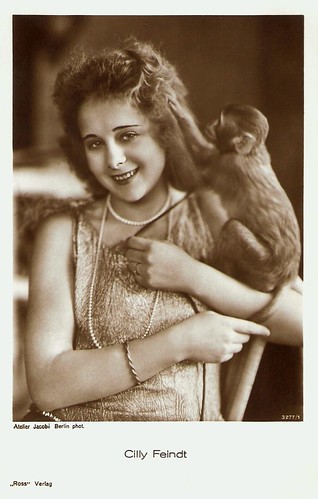
German postcard by Ross Verlag, Berlin, no. 3277/1, 1928-1929. Photo: Atelier Jacobi, Berlin.
The tiny, dainty blonde Cilly Feindt (1909-1999) was a German star of the circus ring. In her heyday, she was regarded as one of the finest Haute Ecole horse riders of her time.
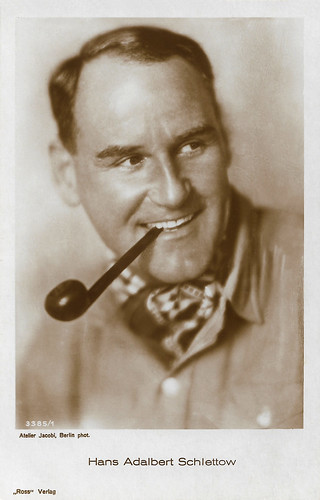
German postcard by Ross Verlag, no. 3385/1, 1928-1929. Photo: Atelier Jacobi, Berlin.
German actor Hans Adalbert Schlettow (1887-1945) appeared between 1917 and 1945 in about 150 German films. He played sinister characters in some masterpieces of the German silent cinema, but in real life, Schlettow proved to be a sinister character as well.
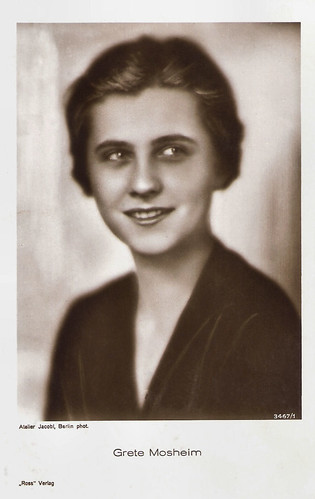
German postcard by Ross Verlag, no. 3467/1, 1928-1929. Photo: Atelier Jacobi, Berlin.
Grete Mosheim (1905-1986) was a German film, theatre and television actress of Hungarian Jewish ancestry. In the late 1920s and early 1930s, she was a star in German cinema.

German postcard by Ross Verlag, no. 3751/1, 1928-1929. Photo: Atelier Jacobi, Berlin.
Austrian actor Fred Louis Lerch (1902-1985) was a handsome star of the Weimar cinema. In the 1950s, he would work again for German films as a production manager.
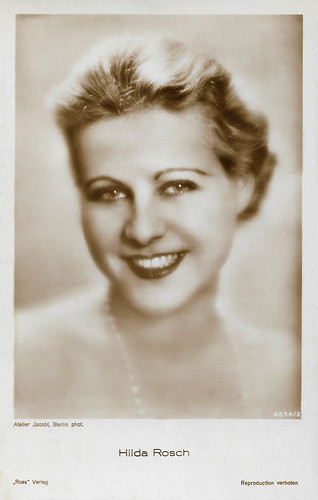
German postcard by Ross Verlag, no. 4054/2, 1929-1930. Photo: Atelier Jacobi, Berlin.
German actress Hilda Rosch only appeared in eight films between 1928 and 1931.
Lotte Jacobi came from a German Jewish family of photographers. Her great-grandfather Samuel Jacobi had reportedly been an apprentice to Louis Daguerre, the photographic pioneer who invented the Daguerreotype process. Samuel, who had been a glazier, founded a photographic studio in the 1840s.
Lotte and her less-known sister Ruth Jacobi (1899-1995) were the daughters of Samuel's grandson Sigismund Jacobi and his wife Mia Jacobi née Lublinski.
From 1920, Ruth Jacobi learned her craft in the photography school of the Lette-Verein photographic school for women in Berlin, then worked for five years in her family's new photo studio at Joachimstaler Strasse 5, later Kurfürstendamm, in Berlin.
Ruth moved to New York in 1928, joining her husband, Hans Richter, whom she had married two years earlier. There she lived and photographed the Jews in the Lower East Side. Returning to Europe in the early 1930s, she divorced Richter in 1933 and then married the Hungarian physician Maurus Roth in Budapest.
The Jacobi-Roth couple emigrated to the USA in 1935. There they lived in Queens. Ruth and her sister Lotte opened a photo studio in New York. During Ruth Jacobi's lifetime, there were no exhibitions of her pictures; however, some have been published.
The dust jacket of Michael Gold’s best-selling novel 'Jews Without Money' (1930) showed one of her pictures. Between 1937 and 1939 she was able to publish several pictures in Popular Photography. Some of her portraits of Albert Einstein were used in a biography of the scientist in 1939 and 'U.S. Camera 1940', an illustrated book on the centenary of photography also featured a photograph by Ruth Jacobi-Roth.
Ruth abandoned the craft of photography for which her sister, Lotte Jacobi, became famous, and spent decades living quietly as a doctor’s wife in Astoria, Queens. Ruth died in 1995 and had no children. Her photos and negatives lay in storage with a relative in Mission Viejo, Calif.
In 2004, archivist Aubrey Pomerance learned of the trove of photographs by the lesser-known Ms. Jacobi. Pomerance was the chief archivist at the Jewish Museum Berlin. Pomerance arranged for the Jewish Museum Berlin to acquire much of the collection - some 800 prints and 3,000 negatives - in 2005. And after years of research and preparation, he mounted an exhibition of around 70 images, 'Ruth Jacobi: Photographs', in 2009 in Berlin.
Sewell Chan in The New York Times in 2009: "I was struck by Ruth Jacobi’s images on a recent vacation in Berlin during a visit to the museum, which was designed by Daniel Libeskind and opened in September 2001 (two days before the 9/11 attacks). The works evoked other famous images of early 20th-century life on the Lower East Side — like those made by Helen Levitt and Rebecca Lepkoff — but with a different sensibility and mood."
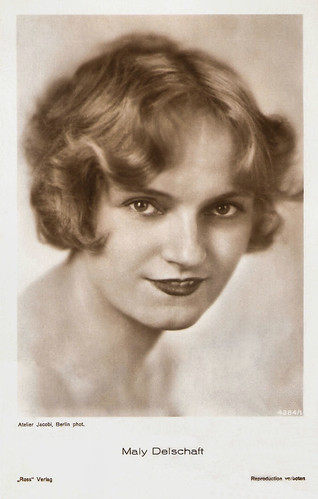
German postcard by Ross Verlag, no. 4384/1, 1929-1930. Photo: Atelier Jacobi, Berlin.
Forgotten diva Maly Delschaft (1898-1995) began her career in the theatre and then became a star in the German silent cinema. During the Nazi era, she appeared mainly in supporting roles. After the Second World War, she worked in East Germany for the state-controlled DEFA studio.
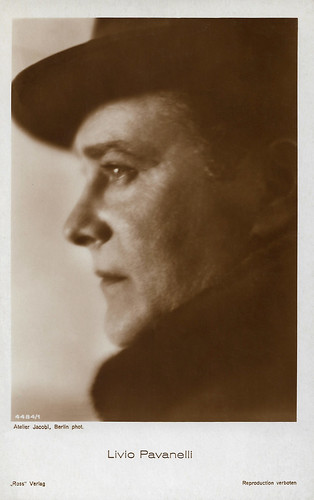
German postcard by Ross Verlag, no. 4484/1, 1929-1930. Photo: Atelier Jacobi, Berlin.
Livio Pavanelli (1881-1958) was an Italian actor of the Italian and in particular German silent cinema. He also worked in Italian sound cinema as an actor and as a production manager. He directed four Italian films, both in the silent and the sound era.

German postcard by Ross Verlag, no. 4772/1, 1929-1930. Photo: Atelier Jacobi, Berlin.
Dignified German-Russian actress Olga Tschechova (1897-1980) was one of the most popular stars of the silent film era. She remained a mysterious person throughout her life and was reportedly a Russian agent in Nazi Germany.

German postcard. Ross Verlag, no. 4879/1, 1929-1930. Photo: Atelier Jacobi, Berlin.
German actress Toni van Eyck (1910-1988) became a star playing a rape victim in the Aufklärungsfilm Gefahren der Liebe/Hazards of Love (1931). Despite this film's success, she stayed primarily a stage actress.
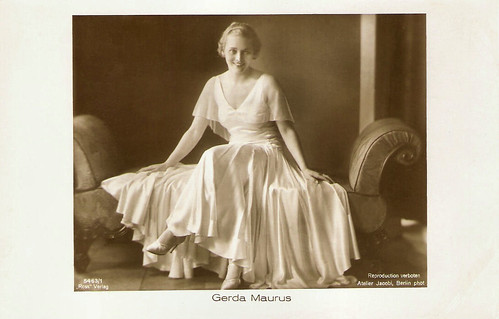
German postcard by Ross Verlag, no. 5463/1, 1930-1931. Photo: Atelier Jacobi, Berlin.
Austrian actress Gerda Maurus (1903-1968) was a star of the silent screen. With her protruded cheekbones and her forceful look, she bewitched many men, including her director Fritz Lang and Nazi Minister Josef Goebbels.
Johanna Alexandra Jacobi was born in 1895 in Thorn, West Prussia (now Torun, Poland). She was the eldest of three children. The name "Lotte" was a nickname given to her by her father. She began her photographic career at 14, documenting the world around her with a homemade pinhole camera.
In 1916 she married Fritz Honig, and a year later she gave birth to a son, John Frank. The marriage did not last, and in 1924 they divorced. In 1925, she joined her parents and her sister, Ruth, in Berlin, where the family had moved in 1921.
From 1925 till 1927, she attended the Bavarian State Academy of Photography and studied art history at the University of Munich. Lotte was in her early thirties when she finished her studies. Jacobi entered the family photography business in 1927. Following an apprenticeship with her father, she became the director of Atelier Jacobi. During this same period, she began her professional career as a photographer, represented by Agentur Schostal (Schostal Photo Agency) and she also produced four films, the most important being Portrait of the Artist, a study of Josef Scharl.
She was equipped for the job not only by talent but by temperament. An emancipated woman with a leftist political slant, she had an inquiring approach and a knack for bringing subjects to her lens. Her subjects were the arts, theatre, film, and dance. Her aim was to capture each sitter's individuality. "In making portraits, I refuse to photograph myself," she said. "My style is the style of the people I photograph."
One of her famous subjects was Peter Lorre. She was allowed only one image, and it turned out to be a classic, with Lorre shot as close up as possible. She captured his villainous look but softened the angle by shooting from above.
Her interest in modern dance led her to take photos of dancers in action, aided by her own quickness and new camera technology. Her now-classic photographs of Lotte Lenya holding a cigarette, Emil Jannings casually peeling an apple, and the dancer Claire Bauroff captured the essence of Berlin theatre life.
In 1932 her leftist sympathies led her to do a series of Ernst Thalmann, the Communist candidate that year against Hitler. From October 1932 to January 1933, she made a long trip to the Soviet Union which resulted in rare and interesting shots of street scenes in Moscow and the republics of Tajikistan and Uzbekistan.
She returned to Berlin in February 1933, one month after Hitler came to power. The Nazis questioned her about her trip, her political sympathies, and her Jewish background. After her father's death, Jacobi took on ownership of the Atelier Jacobi with a non-Jewish business partner, Alexander Bender, hoping to avoid Aryanisation. However, Bender did not meet the race law requirements and the studio was threatened with expulsion from the Reichspressekammer. In September 1935, Lotte Jacobi finally left Germany together with her son.

German postcard by Ross Verlag, no. 6008/1, 1931-1932. Photo: Atelier Jacobi, Berlin.
Prima ballerina, dancer, singer and actress Liane Haid (1895-2000) was the first film star of Austria. She was the epitome of the Süßes Wiener Mädel (Sweet Viennese Girl) and from the mid-1910s on she made close to a hundred films.

German postcard by Ross Verlag, no. 6307/1, 1931-1932. Photo: Atelier Jacobi, Berlin.
Austrian opera singer Richard Tauber (1891-1948) was one of the world's finest Mozartian tenors of the 20th century. Some critics commented that "his heart felt every word he sang". He also tested the then-new talking pictures in such popular musical films as Ich küsse Ihre Hand, Madame (1929) with Marlene Dietrich, Das Land des Lächelns (1930) and Melodie der Liebe (1932).

German postcard by Ross Verlag, no. 6308/2, 1931-1932. Photo: Atelier Jacobi, Berlin.
German actress Marianne Winkelstern (1910-1966) became well known as a ballerina in Germany and England. In Germany, she appeared in some silent films and early sound films.
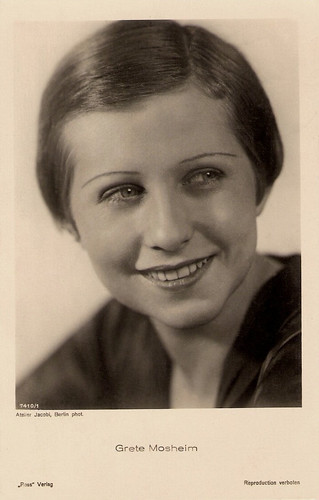
German postcard by Verlag Ross, Berlin, no. 7410/1, 1932-1933. Photo: Atelier Jacobi, Berlin.
Margaret 'Grete' Mosheim (1905-1986) was a German film, theatre and television actress of Hungarian Jewish ancestry. In the late 1920s and early 1930s, she was a star of the Weimar cinema.
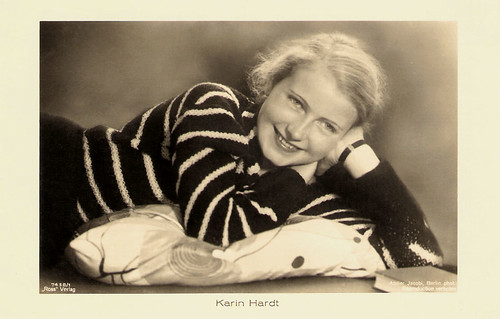
German postcard by Ross Verlag, no. 7438/1, 1932-1933. Photo: Atelier Jacobi, Berlin.
German actress Karin Hardt (1910-1992) made her cinema debut as a pure and disarmingly natural backfisch, looking for happiness. Her impressive career with many film, theatre, and television appearances lasted for six decades.
Lotte Jacobi arrived in September 1935 in New York City. With her sister Ruth Jacobi Roth, she opened a studio in Manhattan, but Lotte struggled to find work. An important American contact was Albert Einstein, whom she and her family had photographed in Germany.
He agreed to work with her when, in 1938, Life magazine commissioned a photo essay on the scientist. She made several informal photographs at Einstein's home in Princeton, N.J., in conversations with his students, but Life felt they were too casual and decided not to publish them.
However, in 1942, the magazine U.S. Camera, at the instigation of Edward Steichen, published a photo of a dreamy Einstein, in a rumpled leather jacket, hair askew, that became one of the most famous images of him.
In the 1940s Jacobi explored the technique of photogenics, expressive abstract images made by drawing with a flashlight on photographic paper. The process had been extensively explored in the early 20th century by Man Ray and Laszlo Moholy-Nagy.
In 1940, in New York, she married her second husband (she and her first husband had divorced), Erich Reiss, a German avant-garde publisher and writer, who was rescued from a Nazi death camp. He died in 1951.
In 1955, Jacobi left New York with her son and daughter-in-law and moved to Deering, New Hampshire, a move that changed her life. There she opened a new studio and served as a mentor to younger artists for 30 years. She continued her interest in the forms of nature, taking pictures of snow, water, and other phenomena in the countryside.
She remained active as a portrait photographer, developing a new set of subjects and friends, including the poets Robert Frost and May Sarton, the ecological activists Helen and Scott Nearing, and a fellow photographer, Paul Caponigro. Among her other notable portraits – all in black and white – were those of the dramatist Kurt Weill, Eleanor Roosevelt, Marc Chagall, and the musician Pablo Casals.
Lotte Jacobi passed away in 1990 at the age of 93. She bequeathed a collection of 47,000 negatives to the University of New Hampshire. Her earlier work was lost to the Nazis, but this post offers a glimpse of the film star portraits she took in Berlin.
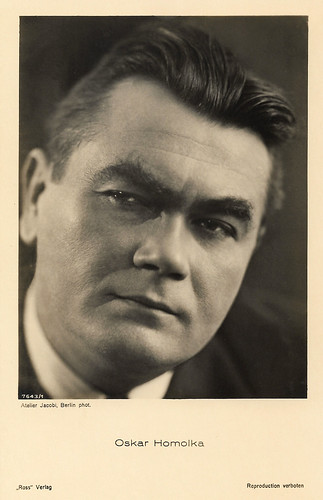
German postcard by Ross Verlag, no. 7643/1, 1932-1933. Photo: Atelier Jacobi, Berlin.
Austrian film and theatre actor Oskar Homolka (1898-1978) had a stocky appearance, bushy eyebrows and a rather Slavic-sounding name, which led many to believe he was Eastern European or Russian. His expressive face predestined him to play character roles as a scoundrel, pimp or communist spy.
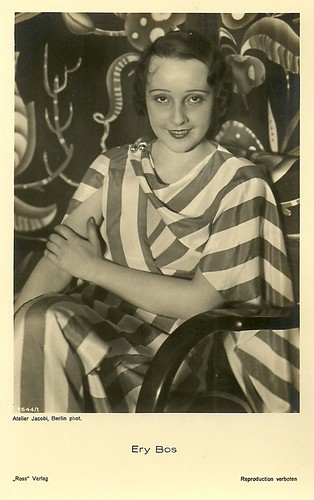
German postcard by Ross Verlag, no. 7644/1, 1932-1933. Photo: Atelier Jacobi.
The Dutch-German actress Ery Bos (1910-2005) had a short but productive film career in the early German sound film. In only three years, from 1932 to 1934 she took part in a dozen films.
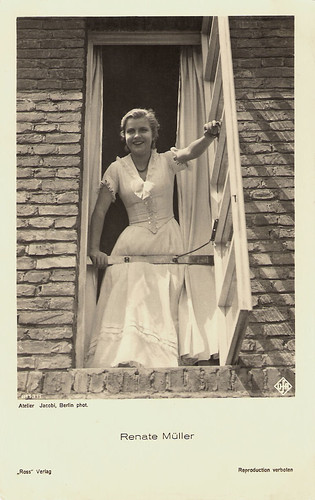
German postcard by Ross Verlag, no. 8113/1, 1933-1934. Photo: Atelier Jacobi, Berlin / Ufa.
Popular actress Renate Müller (1906-1937) was the toast of late 1920s Berlin. She had a comet-like career in the early German sound cinema, that was abruptly ended by her mysterious early death.
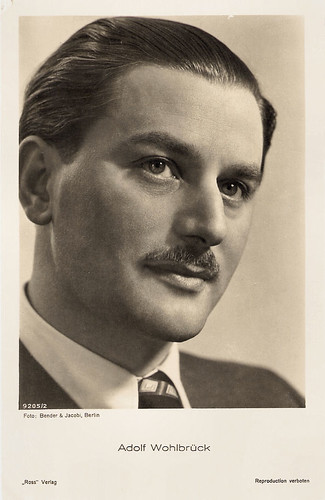
German postcard by Ross Verlag, no. 9205/2, 1935-1936. Photo: Bender & Jacobi, Berlin. These portraits of Adolf Wohlbrück were taken when Lotte Jacobi and her non-Jewish business partner Alexander Bender had taken over Atelier Jacobi.

German postcard by Ross Verlag, no. 9205/3, 1935-1936. Photo: Bender & Jacobi, Berlin.
Dark and handsome Adolf Wohlbrück (1896-1967) was a distinguished Austrian actor who starred in early German sound films as Walzerkrieg (1933) and Viktor und Viktoria (1933). After the rise of Hitler, he settled in Great Britain where he appeared as Anton Walbrook in such film classics as The Life and Death of Colonel Blimp (1943) and The Red Shoes (1948). He also played the ringmaster in La Ronde (1950).
Sources: Sewell Chan (The New York Times), Lynne Warren (Encyclopedia of Twentieth-Century Photography), Jewish Virtual Library, Wikipedia and Peoplepill.com (German).

German postcard by Ross Verlag, Berlin, no. 3277/1, 1928-1929. Photo: Atelier Jacobi, Berlin.
The tiny, dainty blonde Cilly Feindt (1909-1999) was a German star of the circus ring. In her heyday, she was regarded as one of the finest Haute Ecole horse riders of her time.

German postcard by Ross Verlag, no. 3385/1, 1928-1929. Photo: Atelier Jacobi, Berlin.
German actor Hans Adalbert Schlettow (1887-1945) appeared between 1917 and 1945 in about 150 German films. He played sinister characters in some masterpieces of the German silent cinema, but in real life, Schlettow proved to be a sinister character as well.

German postcard by Ross Verlag, no. 3467/1, 1928-1929. Photo: Atelier Jacobi, Berlin.
Grete Mosheim (1905-1986) was a German film, theatre and television actress of Hungarian Jewish ancestry. In the late 1920s and early 1930s, she was a star in German cinema.

German postcard by Ross Verlag, no. 3751/1, 1928-1929. Photo: Atelier Jacobi, Berlin.
Austrian actor Fred Louis Lerch (1902-1985) was a handsome star of the Weimar cinema. In the 1950s, he would work again for German films as a production manager.

German postcard by Ross Verlag, no. 4054/2, 1929-1930. Photo: Atelier Jacobi, Berlin.
German actress Hilda Rosch only appeared in eight films between 1928 and 1931.
A family of photographers
Lotte Jacobi came from a German Jewish family of photographers. Her great-grandfather Samuel Jacobi had reportedly been an apprentice to Louis Daguerre, the photographic pioneer who invented the Daguerreotype process. Samuel, who had been a glazier, founded a photographic studio in the 1840s.
Lotte and her less-known sister Ruth Jacobi (1899-1995) were the daughters of Samuel's grandson Sigismund Jacobi and his wife Mia Jacobi née Lublinski.
From 1920, Ruth Jacobi learned her craft in the photography school of the Lette-Verein photographic school for women in Berlin, then worked for five years in her family's new photo studio at Joachimstaler Strasse 5, later Kurfürstendamm, in Berlin.
Ruth moved to New York in 1928, joining her husband, Hans Richter, whom she had married two years earlier. There she lived and photographed the Jews in the Lower East Side. Returning to Europe in the early 1930s, she divorced Richter in 1933 and then married the Hungarian physician Maurus Roth in Budapest.
The Jacobi-Roth couple emigrated to the USA in 1935. There they lived in Queens. Ruth and her sister Lotte opened a photo studio in New York. During Ruth Jacobi's lifetime, there were no exhibitions of her pictures; however, some have been published.
The dust jacket of Michael Gold’s best-selling novel 'Jews Without Money' (1930) showed one of her pictures. Between 1937 and 1939 she was able to publish several pictures in Popular Photography. Some of her portraits of Albert Einstein were used in a biography of the scientist in 1939 and 'U.S. Camera 1940', an illustrated book on the centenary of photography also featured a photograph by Ruth Jacobi-Roth.
Ruth abandoned the craft of photography for which her sister, Lotte Jacobi, became famous, and spent decades living quietly as a doctor’s wife in Astoria, Queens. Ruth died in 1995 and had no children. Her photos and negatives lay in storage with a relative in Mission Viejo, Calif.
In 2004, archivist Aubrey Pomerance learned of the trove of photographs by the lesser-known Ms. Jacobi. Pomerance was the chief archivist at the Jewish Museum Berlin. Pomerance arranged for the Jewish Museum Berlin to acquire much of the collection - some 800 prints and 3,000 negatives - in 2005. And after years of research and preparation, he mounted an exhibition of around 70 images, 'Ruth Jacobi: Photographs', in 2009 in Berlin.
Sewell Chan in The New York Times in 2009: "I was struck by Ruth Jacobi’s images on a recent vacation in Berlin during a visit to the museum, which was designed by Daniel Libeskind and opened in September 2001 (two days before the 9/11 attacks). The works evoked other famous images of early 20th-century life on the Lower East Side — like those made by Helen Levitt and Rebecca Lepkoff — but with a different sensibility and mood."

German postcard by Ross Verlag, no. 4384/1, 1929-1930. Photo: Atelier Jacobi, Berlin.
Forgotten diva Maly Delschaft (1898-1995) began her career in the theatre and then became a star in the German silent cinema. During the Nazi era, she appeared mainly in supporting roles. After the Second World War, she worked in East Germany for the state-controlled DEFA studio.

German postcard by Ross Verlag, no. 4484/1, 1929-1930. Photo: Atelier Jacobi, Berlin.
Livio Pavanelli (1881-1958) was an Italian actor of the Italian and in particular German silent cinema. He also worked in Italian sound cinema as an actor and as a production manager. He directed four Italian films, both in the silent and the sound era.

German postcard by Ross Verlag, no. 4772/1, 1929-1930. Photo: Atelier Jacobi, Berlin.
Dignified German-Russian actress Olga Tschechova (1897-1980) was one of the most popular stars of the silent film era. She remained a mysterious person throughout her life and was reportedly a Russian agent in Nazi Germany.

German postcard. Ross Verlag, no. 4879/1, 1929-1930. Photo: Atelier Jacobi, Berlin.
German actress Toni van Eyck (1910-1988) became a star playing a rape victim in the Aufklärungsfilm Gefahren der Liebe/Hazards of Love (1931). Despite this film's success, she stayed primarily a stage actress.

German postcard by Ross Verlag, no. 5463/1, 1930-1931. Photo: Atelier Jacobi, Berlin.
Austrian actress Gerda Maurus (1903-1968) was a star of the silent screen. With her protruded cheekbones and her forceful look, she bewitched many men, including her director Fritz Lang and Nazi Minister Josef Goebbels.
My style is the style of the people I photograph
Johanna Alexandra Jacobi was born in 1895 in Thorn, West Prussia (now Torun, Poland). She was the eldest of three children. The name "Lotte" was a nickname given to her by her father. She began her photographic career at 14, documenting the world around her with a homemade pinhole camera.
In 1916 she married Fritz Honig, and a year later she gave birth to a son, John Frank. The marriage did not last, and in 1924 they divorced. In 1925, she joined her parents and her sister, Ruth, in Berlin, where the family had moved in 1921.
From 1925 till 1927, she attended the Bavarian State Academy of Photography and studied art history at the University of Munich. Lotte was in her early thirties when she finished her studies. Jacobi entered the family photography business in 1927. Following an apprenticeship with her father, she became the director of Atelier Jacobi. During this same period, she began her professional career as a photographer, represented by Agentur Schostal (Schostal Photo Agency) and she also produced four films, the most important being Portrait of the Artist, a study of Josef Scharl.
She was equipped for the job not only by talent but by temperament. An emancipated woman with a leftist political slant, she had an inquiring approach and a knack for bringing subjects to her lens. Her subjects were the arts, theatre, film, and dance. Her aim was to capture each sitter's individuality. "In making portraits, I refuse to photograph myself," she said. "My style is the style of the people I photograph."
One of her famous subjects was Peter Lorre. She was allowed only one image, and it turned out to be a classic, with Lorre shot as close up as possible. She captured his villainous look but softened the angle by shooting from above.
Her interest in modern dance led her to take photos of dancers in action, aided by her own quickness and new camera technology. Her now-classic photographs of Lotte Lenya holding a cigarette, Emil Jannings casually peeling an apple, and the dancer Claire Bauroff captured the essence of Berlin theatre life.
In 1932 her leftist sympathies led her to do a series of Ernst Thalmann, the Communist candidate that year against Hitler. From October 1932 to January 1933, she made a long trip to the Soviet Union which resulted in rare and interesting shots of street scenes in Moscow and the republics of Tajikistan and Uzbekistan.
She returned to Berlin in February 1933, one month after Hitler came to power. The Nazis questioned her about her trip, her political sympathies, and her Jewish background. After her father's death, Jacobi took on ownership of the Atelier Jacobi with a non-Jewish business partner, Alexander Bender, hoping to avoid Aryanisation. However, Bender did not meet the race law requirements and the studio was threatened with expulsion from the Reichspressekammer. In September 1935, Lotte Jacobi finally left Germany together with her son.

German postcard by Ross Verlag, no. 6008/1, 1931-1932. Photo: Atelier Jacobi, Berlin.
Prima ballerina, dancer, singer and actress Liane Haid (1895-2000) was the first film star of Austria. She was the epitome of the Süßes Wiener Mädel (Sweet Viennese Girl) and from the mid-1910s on she made close to a hundred films.

German postcard by Ross Verlag, no. 6307/1, 1931-1932. Photo: Atelier Jacobi, Berlin.
Austrian opera singer Richard Tauber (1891-1948) was one of the world's finest Mozartian tenors of the 20th century. Some critics commented that "his heart felt every word he sang". He also tested the then-new talking pictures in such popular musical films as Ich küsse Ihre Hand, Madame (1929) with Marlene Dietrich, Das Land des Lächelns (1930) and Melodie der Liebe (1932).

German postcard by Ross Verlag, no. 6308/2, 1931-1932. Photo: Atelier Jacobi, Berlin.
German actress Marianne Winkelstern (1910-1966) became well known as a ballerina in Germany and England. In Germany, she appeared in some silent films and early sound films.

German postcard by Verlag Ross, Berlin, no. 7410/1, 1932-1933. Photo: Atelier Jacobi, Berlin.
Margaret 'Grete' Mosheim (1905-1986) was a German film, theatre and television actress of Hungarian Jewish ancestry. In the late 1920s and early 1930s, she was a star of the Weimar cinema.

German postcard by Ross Verlag, no. 7438/1, 1932-1933. Photo: Atelier Jacobi, Berlin.
German actress Karin Hardt (1910-1992) made her cinema debut as a pure and disarmingly natural backfisch, looking for happiness. Her impressive career with many film, theatre, and television appearances lasted for six decades.
A dreamy Einstein, in a rumpled leather jacket, hair askew
Lotte Jacobi arrived in September 1935 in New York City. With her sister Ruth Jacobi Roth, she opened a studio in Manhattan, but Lotte struggled to find work. An important American contact was Albert Einstein, whom she and her family had photographed in Germany.
He agreed to work with her when, in 1938, Life magazine commissioned a photo essay on the scientist. She made several informal photographs at Einstein's home in Princeton, N.J., in conversations with his students, but Life felt they were too casual and decided not to publish them.
However, in 1942, the magazine U.S. Camera, at the instigation of Edward Steichen, published a photo of a dreamy Einstein, in a rumpled leather jacket, hair askew, that became one of the most famous images of him.
In the 1940s Jacobi explored the technique of photogenics, expressive abstract images made by drawing with a flashlight on photographic paper. The process had been extensively explored in the early 20th century by Man Ray and Laszlo Moholy-Nagy.
In 1940, in New York, she married her second husband (she and her first husband had divorced), Erich Reiss, a German avant-garde publisher and writer, who was rescued from a Nazi death camp. He died in 1951.
In 1955, Jacobi left New York with her son and daughter-in-law and moved to Deering, New Hampshire, a move that changed her life. There she opened a new studio and served as a mentor to younger artists for 30 years. She continued her interest in the forms of nature, taking pictures of snow, water, and other phenomena in the countryside.
She remained active as a portrait photographer, developing a new set of subjects and friends, including the poets Robert Frost and May Sarton, the ecological activists Helen and Scott Nearing, and a fellow photographer, Paul Caponigro. Among her other notable portraits – all in black and white – were those of the dramatist Kurt Weill, Eleanor Roosevelt, Marc Chagall, and the musician Pablo Casals.
Lotte Jacobi passed away in 1990 at the age of 93. She bequeathed a collection of 47,000 negatives to the University of New Hampshire. Her earlier work was lost to the Nazis, but this post offers a glimpse of the film star portraits she took in Berlin.

German postcard by Ross Verlag, no. 7643/1, 1932-1933. Photo: Atelier Jacobi, Berlin.
Austrian film and theatre actor Oskar Homolka (1898-1978) had a stocky appearance, bushy eyebrows and a rather Slavic-sounding name, which led many to believe he was Eastern European or Russian. His expressive face predestined him to play character roles as a scoundrel, pimp or communist spy.

German postcard by Ross Verlag, no. 7644/1, 1932-1933. Photo: Atelier Jacobi.
The Dutch-German actress Ery Bos (1910-2005) had a short but productive film career in the early German sound film. In only three years, from 1932 to 1934 she took part in a dozen films.

German postcard by Ross Verlag, no. 8113/1, 1933-1934. Photo: Atelier Jacobi, Berlin / Ufa.
Popular actress Renate Müller (1906-1937) was the toast of late 1920s Berlin. She had a comet-like career in the early German sound cinema, that was abruptly ended by her mysterious early death.

German postcard by Ross Verlag, no. 9205/2, 1935-1936. Photo: Bender & Jacobi, Berlin. These portraits of Adolf Wohlbrück were taken when Lotte Jacobi and her non-Jewish business partner Alexander Bender had taken over Atelier Jacobi.

German postcard by Ross Verlag, no. 9205/3, 1935-1936. Photo: Bender & Jacobi, Berlin.
Dark and handsome Adolf Wohlbrück (1896-1967) was a distinguished Austrian actor who starred in early German sound films as Walzerkrieg (1933) and Viktor und Viktoria (1933). After the rise of Hitler, he settled in Great Britain where he appeared as Anton Walbrook in such film classics as The Life and Death of Colonel Blimp (1943) and The Red Shoes (1948). He also played the ringmaster in La Ronde (1950).
Sources: Sewell Chan (The New York Times), Lynne Warren (Encyclopedia of Twentieth-Century Photography), Jewish Virtual Library, Wikipedia and Peoplepill.com (German).
No comments:
Post a Comment